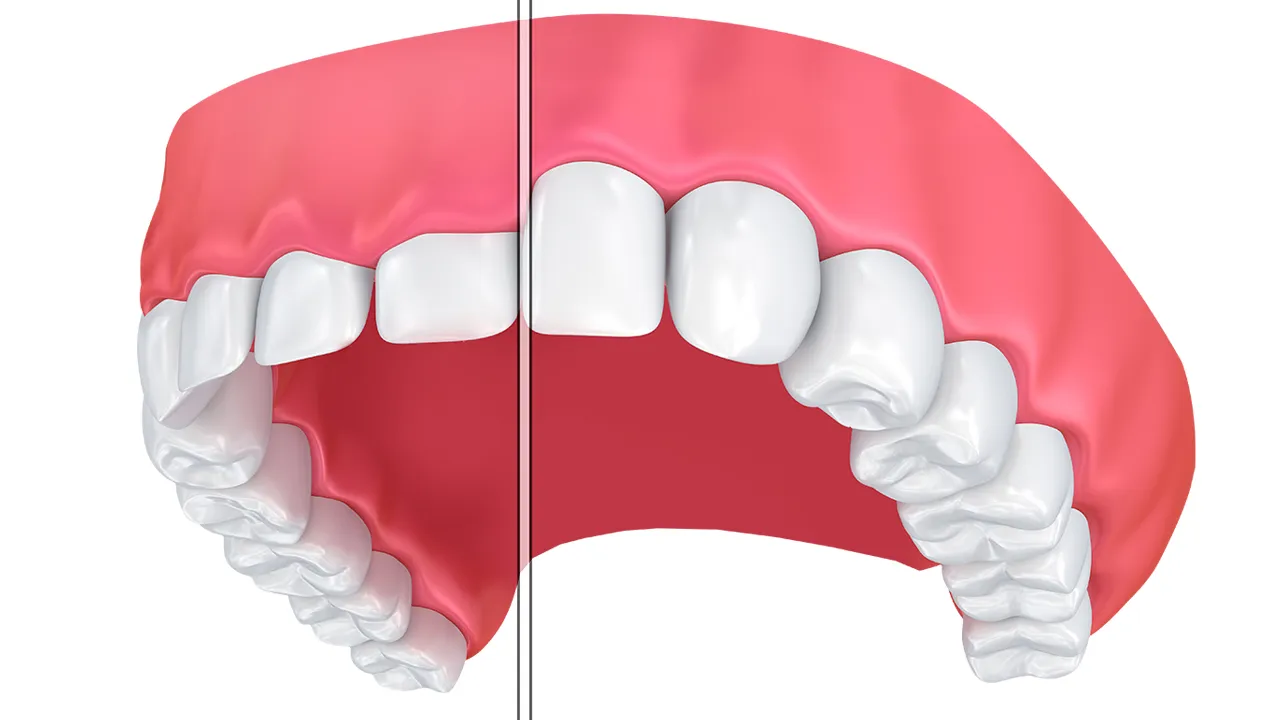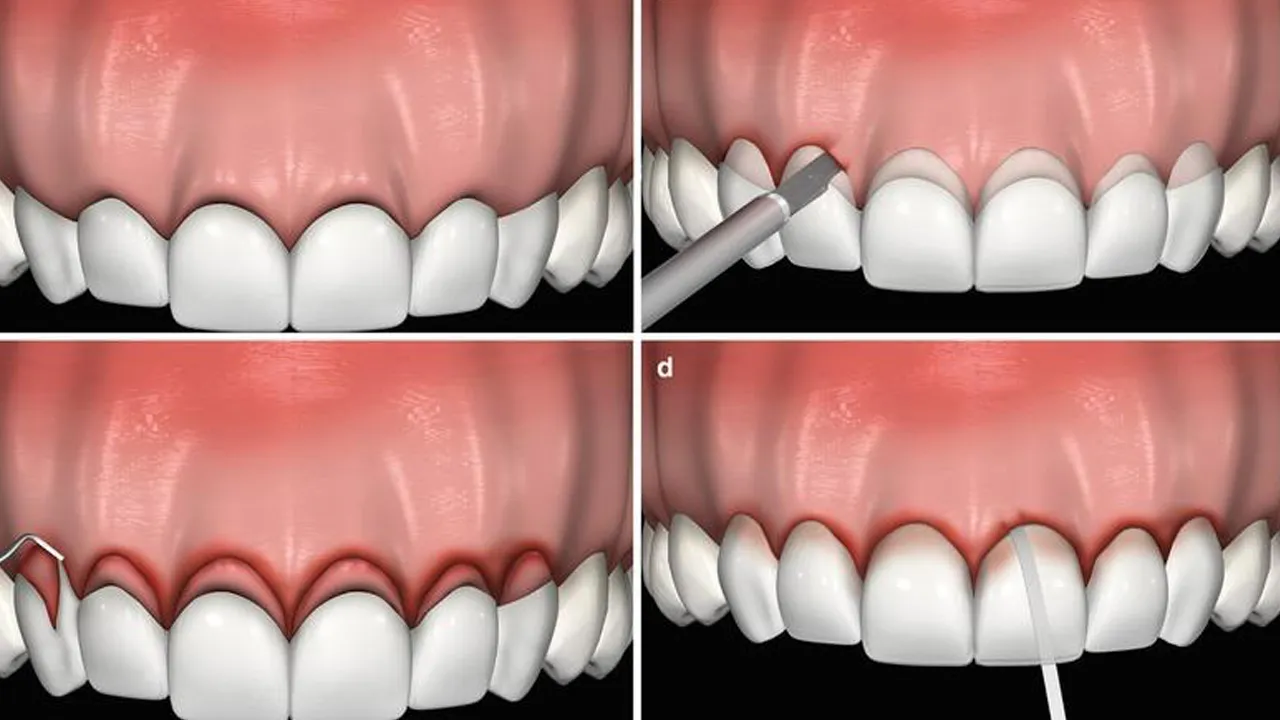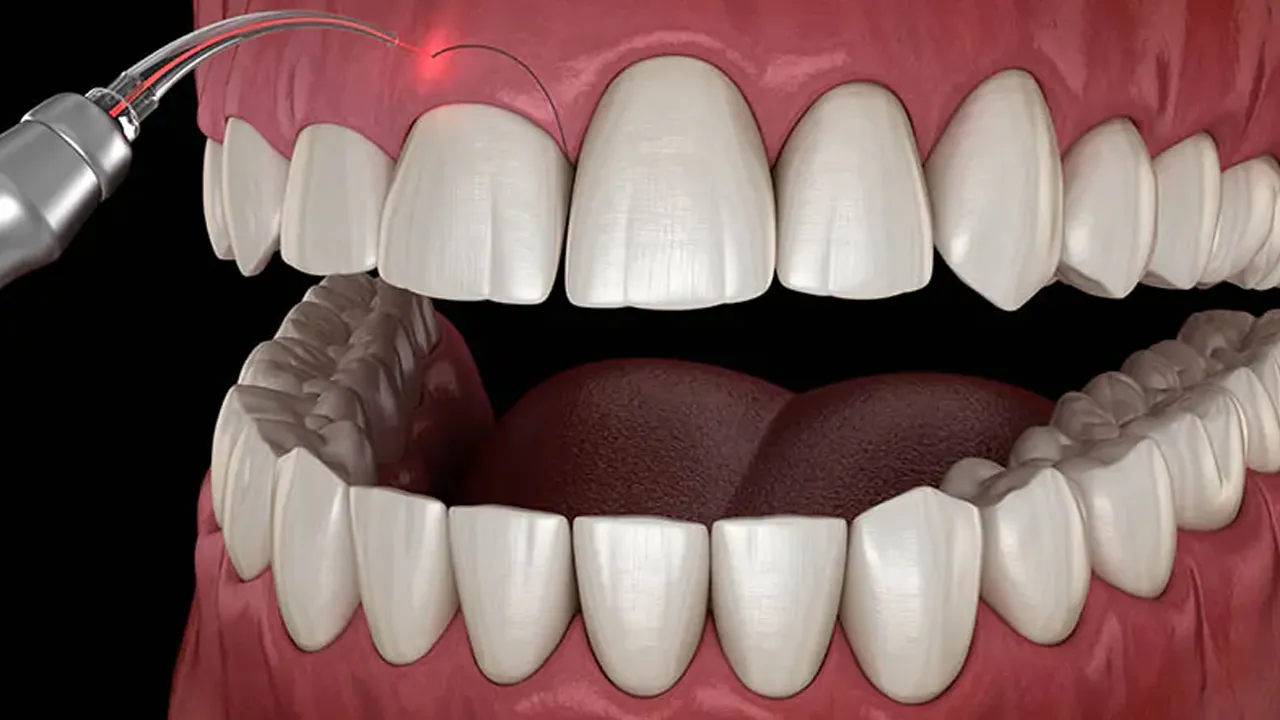Gum contouring is a dental operation that entails decreasing excess tissues from the gum region. A periodontist, a dentist who specializes in treating illnesses and ailments that affect the soft and hard structures supporting the teeth, often conducts the surgery. In order to enhance the total appearance of the smile, it is performed to correct a "gummy grin," which is when a person's gums appear to be concealing too much of their teeth. Thus it evens up uneven gums and displays more tooth surfaces.
The procedure is typically done using a laser or a scalpel and done in conjunction with other cosmetic dental procedures such as teeth whitening or veneers. The steps of the procedure typically include anesthesia, extraction of extra gum tissue, sculpting of the gums, and the recovery period. Gum contouring is a relatively quick procedure. The amount of time it takes depends on the extent of the work needed and the technique used. The procedure is done in as little as 30 minutes to an hour for minor cases. The procedure takes several hours for more extensive cases. Another term for gum contouring is gum reduction surgery, sometimes people refer to it as gum reshaping. The worth of gum contouring for a single tooth is likely to cost from $ 50 to $350. Contouring the gums of the entire front teeth costs up to $3,000. During the first 24 to 48 hours after the surgery, the patient is likely to experience some bleeding and swelling, which is managed with ice packs and over-the-counter pain medication. The patient should avoid hard or crunchy foods for a few days and stick to soft foods, such as yogurt or soup. The patient is given specific instructions for oral hygiene, including gentle rinsing with warm salt water and avoiding brushing or flossing the treated area for a few days.
Type of Gum Contouring Procedure | Description | Price Range in Turkey (£) | Price Range in UK (£) |
Single Tooth Contouring | Reshaping the gum around a single tooth. | £49 | £200 - £500 |
Full Gum Contouring | Reshaping gums around multiple teeth or full front row. | £200 - £500 | £2,000 - £2,500 |
What is Gum Contouring?
Gum contouring, often referred to as gum reshaping or gum sculpting, is a cosmetic dental operation that includes removing unwanted gum tissue to enhance the appearance of the gums and teeth. Usually, the technique is used to treat "gummy smiles," which occur when a person's gums appear to be overly concealing a significant portion of their teeth.The procedure is typically performed using a laser or a scalpel and executed simultaneously with other cosmetic dental procedures such as teeth whitening or veneers. The procedure is used to even out uneven gums and to expose more tooth surfaces to improve the overall look of the smile. The procedure is usually performed by a periodontist, a dental specialist in the treatment of diseases and conditions that affect the soft and hard tissues supporting the teeth. Gum contouring or reshaping is achieved by utilizing a variety of methods, including Laser gum contouring. The technique comprises precisely shaping the gums and using a laser to remove excess gum tissue. During the operation, the laser closes blood arteries as it cuts, which helps to lessen bleeding and edema during the operation. Another type is Scalpel gum contouring. A scalpel is used to remove extra gum tissue and reshape the gums. It is a technique that is more invasive than laser gum contouring, but it is likely to be useful for larger areas of tissue removal.
 Crown lengthening is used to uncover more of the tooth surface by removing some of the gum tissue. The procedure is done for aesthetic reasons, but it is even done to prepare a tooth for a crown or bridge if there is not enough tooth structure showing to support the restoration. Another type of gum contouring is Soft tissue grafting A soft tissue graft is likely to be used to rebuild the gums in cases where the gums have receded or there is insufficient tissue to support the tooth. It is done with a patient's own tissue or with donated tissue. Pinhole Surgical Technique (PST) is a minimally invasive technique that uses a small hole made in the gums. The process allows the dentist to reshape the gums, bring the receded gums back to their original position and cover exposed roots. These are some of the most common techniques used in gum contouring, and the appropriate technique depends on the specific case and the goals of the procedure.
Crown lengthening is used to uncover more of the tooth surface by removing some of the gum tissue. The procedure is done for aesthetic reasons, but it is even done to prepare a tooth for a crown or bridge if there is not enough tooth structure showing to support the restoration. Another type of gum contouring is Soft tissue grafting A soft tissue graft is likely to be used to rebuild the gums in cases where the gums have receded or there is insufficient tissue to support the tooth. It is done with a patient's own tissue or with donated tissue. Pinhole Surgical Technique (PST) is a minimally invasive technique that uses a small hole made in the gums. The process allows the dentist to reshape the gums, bring the receded gums back to their original position and cover exposed roots. These are some of the most common techniques used in gum contouring, and the appropriate technique depends on the specific case and the goals of the procedure.
When is Gum Contouring needed?
Gum contouring is needed when someone has gums that are too low or too high. Gum contouring is a method chosen by those who are dissatisfied with the appearance of their smiles. Most of the time, gum contouring is thought of as a cosmetic procedure because it makes the gums look nice. While some people consider gum contouring a cosmetic enhancement, others do it for medical reasons. Gum contouring is done post-orthodontic treatment. Sometimes, even after teeth straightening, teeth appear misaligned due to gum position. In such cases, gum contouring is likely to improve the final appearance. A "gummy" smile: Some people have a "gummy" smile, where excessive gum tissue covers a significant portion of the teeth. Gum contouring is used to reduce the appearance of a “gummy smile” and make the teeth look more proportionate. Gum contouring is used to even out a gum line that isn't straight and make the gums look better. People who have teeth that appear too small must consider getting gum contouring. Some people are likely to have gums that are overgrown and conceal a large portion of their teeth, making the teeth appear small. Gum contouring makes the teeth look larger after removing excess gum tissue and revealing more of the tooth surface. Gum contouring is ideal for crowding or misaligned teeth. Gum contouring removes or reshapes gum tissue that is covering or crowding teeth, making it easier to clean and maintain proper oral hygiene.
What are the benefits of Gum Contouring?
Gum contouring, gingival contouring, or gum reshaping, is a cosmetic dental technique that is done to enhance the appearance of the gums and teeth. People who are dissatisfied with their smiles benefit a lot from gum contouring. It enhances someone’s smile and boosts self-confidence.
Below are the Benefits of Gum Contouring.
- Gum contouring improves the look of the teeth: The process involves removing or reshaping excess gum tissue. This makes the teeth look more even and pleasing.
- Enhancing the smile: Gum contouring enhances the overall look of a person's smile by making the teeth look larger and more evenly proportioned.
- Getting rid of the "gummy" smile: Some people have a "gummy" smile, where excessive gum tissue covers a significant portion of the teeth. Gum contouring reduces the appearance of this condition and makes the teeth look more proportionate.
- Reducing the appearance of uneven gum lines: Gum contouring is utilized to even out an unproportioned gum line and improve the symmetry of the gums.
- Improving oral health: Gum contouring removes or reshapes gum tissue that is concealing or crowding teeth, making it easier to clean and maintain proper oral hygiene.
- Minimally invasive: Gum contouring is a minimally invasive technique that usually requires only local anesthesia and is done in one or multiple sessions.

What are the risks of Gum Contouring?
As with any surgical procedure, there are risks always involved. However, generally, gum contouring is safe and some potential risks are minimal.
Below are the Risks of Gum Contouring.
- Teeth Sensitivity: Teeth sensitivity is a usual after-effect of gum contouring. It occurs due to the procedure uncovering more of the tooth exterior, which makes the teeth more delicate to hot and cold temperatures and sweet or acidic foods. This sensitivity normally eases up within a few weeks as the teeth adjust to the new exposure. The sensitivity is likely to last longer or be more severe in rare cases. It happens if the procedure has removed too much gum tissue and uncovered the tooth's root, which does not have the same protective coat as the tooth crown. The process results to root sensitivity, which is treated with special toothpaste or fluoride gel.
- Losing layer of enamel: Losing a layer of enamel after gum contouring is a rare complication. Enamel is the hard, protective outer layer of the tooth that helps to protect the tooth from decay and wear. The enamel layer is not removed during gum contouring, but in some cases, the procedure cause damage to the enamel. This happens if the dentist or periodontist removes too much gum tissue and exposes the tooth's root, which is not as well protected as the tooth crown. The root is more susceptible to decay and erosion, which leads to a loss of enamel. It is important that the dentist or periodontist performs the procedure correctly and not removing too much of the gums, as well as following proper post-operative care to minimize the risk of enamel loss. The dentist or periodontist is likely to give the patient instructions on how to care for their teeth after the procedure to minimize the risk of enamel loss and other complications. In case of enamel loss, a dental restoration such as a filling, crown, or veneer is needed to protect the tooth from further damage and to restore its normal function and appearance.
- Developing tooth decay: Tooth decay (cavities) is a potential complication that develops after gum contouring. Tooth decay happens if the procedure removes too much gum tissue and exposes the tooth's root, which is not as well protected as the tooth crown. The root is more susceptible to decay, especially if the root surface is not properly cleaned and maintained after the procedure. It is essential to follow proper oral hygiene practices, including brushing and flossing regularly, using fluoride toothpaste, and rinsing with an antiseptic mouthwash, to minimize the risk of tooth decay after gum contouring.
- Recession: One potential issue that is likely to come about following gum contouring is gum recession. The recession of the gums is a potential complication that takes place after gum contouring. Gum recession occurs when the gum tissue pulls away from the tooth, uncovering more of the tooth's root. A recession happens if the process extracted too much gum tissue, or if the gums are not properly cared for after the procedure. The recession happens if the process is not executed correctly, the gums are over-contoured, or the person has an underlying condition such as periodontal disease. Following proper oral hygiene practices, including brushing and flossing regularly, using fluoride toothpaste, and rinsing with an antiseptic mouthwash lessens the risk of gum recession following gum contouring.
- Periodontitis: Periodontitis is an acute type of gum disorder. It is caused by the buildup of plaque and tartar on the teeth, which leads to swelling and infection of the gums. Periodontitis causes the gums to detach from the teeth, creating bone loss and tooth loss if left unmedicated. Periodontitis is brought about by a variety of components, along with unhealthy oral hygiene practices, smoking, genetics, and certain medical conditions. It is a complication of gum contouring if the procedure is not performed correctly or if the gums are not properly cared for after the procedure. Symptoms of periodontitis include swollen gums, receding gums, persistent foul breath, loose teeth, and pus between the teeth and gums.
What are the procedures of Gum Contouring?
Gum contouring, sometimes referred to as "gum reshaping” or “gum sculpting,” is a cosmetic dental technique that entails eliminating excess gum tissue to enhance the appearance of the gums and teeth. The first steps of the procedure typically include anesthesia. The patient is given a local anesthetic to numb the area around the gums. Next is the extraction of unwanted gum tissue. The dentist or periodontist uses a laser or scalpel to remove any unwanted gum tissue that is covering the teeth. Then follows the shaping of the gums. The dentist or periodontist reshapes the remaining gum tissue to make it look more even and symmetrical. Recovery of the patient is the last step for gum contouring. The patient is going to experience some swelling and discomfort, but this is taken care of with over-the-counter painkillers and ice packs following the procedure. The gums usually heal in a few weeks, and the final results of the procedure are visible after about a month. Essentially, the procedure is performed by a periodontist, a dentist who specializes in treating diseases and conditions that affect the hard and soft tissues that support the teeth.
How much does a Gum Contouring Cost?
The cost of gum contouring ranges from £49 in Turkey to £2500 in UK on average. Gum contouring for a single tooth costs around £49 in Turkey. Up to £2500 is needed to contour the gums around the entire row of front teeth in UK. The cost of the procedure varies extensively depending on whether one needs a simple reshaping of the gums or more extensive work. Insurance is likely to cover some or all of the cost, depending on the specific process and the insurance policy in some cases. It is always recommended to get a consultation and cost estimate from a dentist before undergoing the process. It's important to ask about the cost and potential insurance coverage during the initial consultation. Generally, the cost of the procedure is considered to be relatively expensive when compared to other types of dental procedures, and it's not always covered by insurance.

How long does it take to Recover from Gum Contouring?
Most people resume their normal activities within a week or two after gum contouring, but it takes several weeks for the treated area to fully heal and for the final results to become apparent. Generally, most people experience some swelling, bleeding, and discomfort for a few days after the procedure. The swelling and bleeding should subside within the first few days, and discomfort typically is managed with over-the-counter pain medication. It's common for the gums to be sensitive for a few weeks and for the treated area to take a few weeks to heal completely. The dentist is likely to give specific instructions on how to care for the gums after the procedure, and it's important to follow these instructions carefully to ensure proper healing. It's important to note that, in some cases, a follow-up procedure is likely to be necessary to achieve the desired results, and is likely to extend the healing period. It's best to follow up with the dentist as advised and be prepared to wait a few weeks for the final outcome.
How to recover from Gum Contouring?
Recovery from gum contouring is generally a relatively straightforward process. There are some steps one must take to help them with a speedy recovery. It is normal to experience some swelling, bleeding, and discomfort after the procedure. Place an ice pack on the affected area for 15-20 minutes at a time to reduce swelling. The dentist is going to recommend that one must use an over-the-counter pain reliever to help manage any discomfort one is likely to experience.
Patients are given specific instructions on how to care for their gums after the procedure. It is essential to follow these instructions carefully to ensure proper healing. Instructions include rinsing the mouth with salt water, avoiding certain foods and drinks, and avoiding brushing or flossing the treated area for a period of time. Patients are advised to eat only soft foods such as eggs, ice cream, and other cold foods. Spicy and crunchy food must be avoided during the healing process. One is likely to be given an appointment to follow up with their dentist a few days or weeks after the procedure to make sure they are healing properly and to address any concerns or questions they have. Practice good oral hygiene and maintain a regular dental check-up schedule in order to keep the gums healthy after gum contouring. Limit physical activity and let the body rest and recover, this way the faster the healing is going to take. Lastly, avoid smoking and other habits that compromises healing and compromise the results of the procedure. Always follow the specific instructions and guidelines given by the dentist to ensure proper healing and achieve the best results.
How long does Gum Contouring last?
The results of gum contouring last for many years. However, the longevity of the outcome relies on several factors such as the patient’s oral health and the extent of the procedure. Regular dental check-ups and good oral hygiene help to maintain the results of gum contouring. It is important to note that if there are any underlying issues that led to the need for gum contouring, such as gum disease, these issues must properly treated and managed to ensure the best long-term outcome. Nonetheless, with proper care, most people are satisfied with the results of gum contouring for many years. It is always advisable to follow the dentist's advice and instructions post-procedure and to schedule regular check-ups to maintain dental health.
What is the side effect of Gum Contouring?
Like any surgical procedure, gum contouring causes some side effects and complications. However, these are generally mild and temporary and be managed with proper care and attention.
Below are the Side Effects of Gum Contouring.
- Swelling and tenderness: Some swelling and tenderness around the gums is normal after gum contouring. These symptoms usually peak within the first 24 to 48 hours after the procedure and should subside within a week.
- Bruising: Bruising occurs around the gums, this is due to the procedure itself or the anesthetic used, and it usually dissipates within a week.
- Pain or discomfort: Some pain or discomfort be expected after gum contouring, however, it be managed with over-the-counter pain medication if prescribed by their dentist.
- Tooth sensitivity: Gum contouring causes temporary tooth sensitivity, particularly to hot or cold temperatures.
- Numbness or tingling in the lip or tongue: These symptoms occur if the anesthetic used during the procedure affects the nerves in the area. These symptoms should go away within a few hours.
- Infection: Any surgical procedure carries the risk of infection, but this is a very rare complication for gum contouring.
- Heavy bleeding: Although rare, some patients experience heavy bleeding after the procedure, if this occurs patient should contact their dentist as soon as possible.
- Partial gum discoloration: Partial gum discoloration, known as hyperpigmentation, is a rare but possible side effect of gum contouring surgery. It occurs when the gums become darker in color than the surrounding tissue. Gum discoloration happens when the gums are injured or irritated during the surgery, leading to the production of more melanin, the pigment that gives color to the skin and gums.
Generally, side effects of gum contouring are usually minimal and temporary, but if a patient experience any unusual symptoms or have any concerns, it's always best to contact the dentist.
Is Gum Contouring have long-term side effects?
No, gum contouring doesn’t have long-term side effects. The procedure is generally regarded as safe and doesn’t cause long-term side effects. There are likely to be some minor complications following the operation. However, the aftereffects are usually normal, like bleeding, swelling in the gum area, numbness, discomfort, and the possibility of infection. It's important to remember that these are normal side effects that are likely to be less severe if one chooses an experienced and qualified periodontist and follows the post-operative instructions given by the periodontist. It's always important to have realistic expectations and to discuss any concerns or querries with the periodontist before the procedure.
Will gums regrow after contouring?
No, the gums will not regrow after contouring. The gums do not have the ability to regrow as the tissue that is removed during the procedure is removed permanently following gum contouring. The remaining gums heal and adapt to the new shape and form after the procedure, the healing process is likely to take several weeks. Regular follow-up visits to the dentist are necessary to monitor the gums and teeth for any changes that are likely to occur, and to make any necessary adjustments to maintain the desired results. These follow-ups are done to check the healing, and oral hygiene and to address any issues that are likely to arise. Always remember that proper oral hygiene and maintaining healthy diet aid in the healing process, and it's essential to keep in mind that good oral hygiene practices, such as regular brushing and flossing, help to maintain the outcome of gum contouring for a longer period of time.
Is Gum Contouring the same as Crown Lengthening?
No, Gum contouring and crown lengthening are related dental processes but are not exactly the same. Gum contouring sometimes called gingivoplasty or soft tissue sculpting is an aesthetic surgery that consists of extracting or adjusting extra gum tissue to show more of the tooth and enhance the overall image of the smile. The process is mainly used to correct an irregular gum line, giving a smile more evenness or balance. Crown lengthening, on the other hand, is a periodontal or restorative procedure that reveals more of the tooth form for the purpose of placing a dental crown or filling. The process is typically executed when a tooth is decayed or broken beneath the gum line, or to correct a “gummy” smile for aesthetic reasons. While both methods focus on the gums, they have different primary purposes and are used in separate situations. However, in some cases, both procedures are done together to achieve the final outcome.
The choice of which is better between gum contouring and crown lengthening depends on the certain situation. Overall, gum contouring is mainly utilized for aesthetic issues of the gum line, and crown lengthening is mainly used to make the tooth ready for a crown or other restorative issues. Gum contouring is ideal for people who have receding gum lines, and people who look to have very long teeth. On the other hand, crown lengthening is ideal for people who suffer from a “gummy smile”, and have teeth that appear to be short.
Are Gum Contouring Results Permanent?
Yes, gum contouring results are permanent, as tissue does not regrow. Contouring the gum entails removing excess gum tissues to enhance the look of the gums and teeth. However, it's important to note that the remaining gums are still subject to changes over time due to factors such as age, hormones, genetics, and oral hygiene. Therefore, it's essential to maintain good oral hygiene and schedule regular dental check-ups to ensure that the gums remain healthy.





